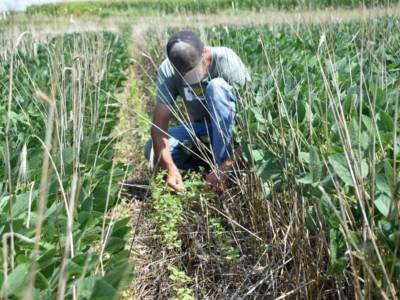| Title XI: Crop Insurance | |||
Title II: Conservation
What it does: Authorizes and provides mandatory funding for conservation programs. They include the Conservation Reserve Program, which pays landowners to retire environmentally sensitive acreage; the Environmental Quality Incentives Program, which provides cost-share assistance for practices, equipment and structures that address natural resource concerns; and the Conservation Stewardship Program, which provides annual payments to farmers who undertake conservation practices.
The Regional Conservation Partnership Program funds public-private projects. The Agricultural Conservation Easement Program pays landowners for protecting wetlands or preventing development of farmland.
Both EQIP and CSP have been oversubscribed in recent years, despite EQIP receiving a 10-year budget increase of more than $1 billion in the 2018 farm bill.

The conservation programs were projected to cost $59.7 billion over 10 years under the 2018 farm bill. EQIP, CSP, RCPP and ACEP received a total of $17 billion in additional new funding in 2022 through the Inflation Reduction Act for promotion of climate-smart farming practices. Under the budget reconciliation rules used to pass the IRA, the funding must be distributed by the end of fiscal 2031.
What it costs: Not counting the IRA funding, $60 billion, or 4%, of the projected 10-year cost of farm bill programs through 2033.
What's in play: The biggest issue by far is whether to bring the IRA funding into the farm bill. The money could then be reallocated so that it could provide a permanent increase in funding for conservation programs beyond the 2031 cutoff date imposed by the budget reconciliation rules.
Senate Agriculture Committee Chairwoman Debbie Stabenow, D-Mich., would have to go along with moving the IRA money into the farm bill. She has insisted the funding remain dedicated to increasing adaptation of climate-related practices. The committee’s ranking Republican, John Boozman of Arkansas, has said he respects that “red line.”
The Conservation Reserve Program, which wasn’t touched by the IRA, will likely receive some attention. Republicans on the House Agriculture Committee are considering a number of major changes to the program, including eliminating the program's national acreage cap in lieu of an overall limit on funding and giving state Farm Service Agency offices the authority to determine how many acres could be enrolled within their borders in the General, Grasslands and Continuous sign-ups.
Some producers would also like to see CRP payment rates increased for the southern and western Plains to attract more acreage under CRP’s general signup. Sen. Michael Bennet, D-Colo., argues the rates are too low.
On the other hand, Sens. Chuck Grassley, R-Iowa, and Cory Booker, D-N.J., have called for reducing the overall acreage cap from 27 million acres to 24 million acres while increasing payments for more environmentally sensitive tracts that can be enrolled through rules of the Continuous CRP signup. Enrollment in CRP Grasslands and Continuous programs has been steadily increasing in recent years, while general CRP enrollment has declined in recent years, according to University of Illinois economists.
Other things to watch out for include a push by Prairie Pothole Republicans to do away with the NRCS’s ability to enter into permanent easement agreements, an effort to increase funding for the Conservation Stewardship Program, and a proposal to create a small farm subprogram under EQIP.
Notable marker bills:
S.1509 — The Conservation Reserve Program Reform Act, led by Booker and Grassley.
S.174 — The Conservation Reserve Program Improvement Act, led by Sen. John Thune, R-S.D., would permanently establish the State Acres for Wildlife Enhancement initiative under Continuous CRP and increase the CRP annual rental payment limitation from $50,000 to $125,000.
H.R.4800 — Bipartisan proposal led by Rep. Jimmy Panetta, D-Calif., to exempt producers from means testing for conservation programs, if most of their income is from agriculture.
H.R.2975 — A bill led by Rep. Kim Schrier, D-Wash., to permanently authorize the State Acres For Wildlife Enhancement initiative.
H.R.3779 — A bill by Rep. Thomas Tiffany, R-Wis., would impose a one-year moratorium on CRP enrollment and restrict the type of land that could be put in the program after that.
S.1365 and H.R.2942 — The Conservation Reserve Program Amendments Act, proposed by Sen. Marco Rubio, R-Fla., and Scott Franklin, R-Fla., would allow enrollment of citrus acreage.
H.R.4425 — The Food and Farm Act, a sweeping proposal led by Rep. Earl Blumenauer, D-Ore., would, among other things, bar concentrated animal feeding operations from EQIP and prioritize EQIP for projects that “demonstrably improve the quality of the environment.”
S.1078 — The NRCS Wetland Compliance and Appeals Reform Act, led by Sen. Mike Rounds, R-S.D., would bar the Natural Resources Conservation Service from signing permanent easements and would require USDA to establish state oversight committees to oversee appeals of wetland determinations.
H.R. 1459 — The Precise Act, led by Rep. Ashley Hinson, R-Iowa, would increase EQIP and CSP assistance for precision agriculture technology.
H.R. 708 — The Climate Agricultural Conservation Practices Act, led by Julia Brownley, D-Calif., would require NRCS to consider climate concerns in revising conservation practice standards.
S.658 — The EQIP Improvement Act, led by Booker and Sen. Mike Lee, R-Utah, would eliminate the requirement that 50% of EQIP funding go to livestock operations and reduce the payment limit from $450,000 to $150,000.
S.2180 — A proposal led by Sen. Michael Bennet, D-Colo., to create a small farm subprogram under EQIP.
S.2412 — The Conservation Reserve Program Flexibility Act, led by Sen. John Thune, R-S.D., would allow the USDA to permit emergency haying of land in the CRP program before the primary nesting season begins if certain conditions are met.
S.2250 and H.R.4902 — The Voluntary Groundwater Conservation Act would add voluntary groundwater easements into the Agricultural Conservation Easements Program. Producers could agree to reduce their groundwater use through these contracts in exchange for compensation based on the value of their water rights.
H.R.4800 — The Growing Access To Environmental Sustainability Act would exempt producers that get 75% of their income from farming, agri-tourism, or other agricultural-related activities from Adjusted Gross Income limitations in CRP, EQIP and CSP.






